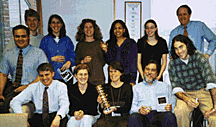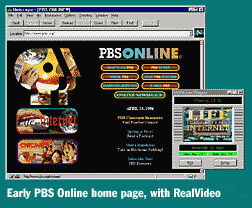

 |
Posing with staffers, online chief Cindy Johanson clutches a 1998 Webby Award. In the TV category, PBS won the professionally judged competition this spring after winning the "people's choice" Webby based on web-user votes in 1997. |
PBS Online gets faster web connection, relaunch of its site for teachers
PBS Online is celebrating its third anniversary this week with a doubled staff, an expanded mission, an upgraded teachers' service that opens next month, and a much faster connection with the Internet, to be turned on this month.
 In the three years since PBS turned on its site, the web has grown to 39
million users a week in this country, with online ad sales approaching $1
billion. During the same period, public broadcasting's largest web site,
PBS's, has built an audience of more than 2 million unique visitors a month,
who choose among some 50,000 pages. Things have moved so fast, says PBS Online
chief Cindy Johanson, "it seems like it was 10 years ago, not three."
In the three years since PBS turned on its site, the web has grown to 39
million users a week in this country, with online ad sales approaching $1
billion. During the same period, public broadcasting's largest web site,
PBS's, has built an audience of more than 2 million unique visitors a month,
who choose among some 50,000 pages. Things have moved so fast, says PBS Online
chief Cindy Johanson, "it seems like it was 10 years ago, not three."
PBS expanded its Internet connection by one-third last February, and demand soon had it hitting the ceiling again. Peaks become plateaus, new peaks occur, and now PBS is again leasing a larger "pipe" to the Internet, boosting capacity 3.5-fold, from 6 megabits-per-second to 21, says Dave Johnston, PBS Online director of technology.
The public TV network, whose formula since the start has been to go beyond tune-in promotion and glitz to offer substantive supplements to broadcasts, now gets repeated praise for "understanding" what the web can do best.
The site is due for another graphic and navigational makeover early in 1999, and its producers are debating "cookies" and other technologies they could use to personalize the site for visitors. For instance, they'd like to find a way to automatically make available the appropriate local program schedules when a user comes to the site, says Johanson.
Focus on teachers
Posing for a snapshot with staffers, online chief Cindy Johanson clutches
a 1998 Webby Award. In the TV category, PBS won the professionally judged
competition this spring after winning the "people's choice" Webby
based on web-user votes in 1997.
In the meantime, next month, PBS Online will relaunch its Learn with PBS
section as "PBS TeacherSource," with improved navigational systems
and expanded content.
The site for teachers already was one of the top three web sites cited by elementary/secondary educators in a Dun & Bradstreet survey two years ago, along with the National Geographic Society and NASA. In June, teachers responding to a questionnaire on the PBS site gave PBS and National Geo top marks for excellence, with the Discovery Channel a distant third.
A major change in TeacherSource will be improved navigation — "a new front door and lots of side doors" to the many program-related pages that already offer some 1,000 lesson plans and classroom activities, according to Johanson.
In focus groups with educators, PBS Online also found that teachers— always rushing to find specific curricular subject matter— were disappointed in the performance of PBS's site-search mechanism. The staff is now revising page-coding to improve search accuracy, says education producer Mary Halnon.
Producers are setting up standard links to integrate local stations' educational pages into the national site. PBS is giving page templates to stations to help them post localized material, such as state curricular standards and local events for teachers. Shelley Santora, a veteran of WETA Online, was assigned as PBS Online's ambassador to stations.
The site will offer a teachers' version of ShopPBS to sell videocassettes and other teaching materials online, and will soon debut a new PBS VideoDatabase of America's History and Culture. The database, which answers teachers' need for video illustrating narrow lesson topics, indexes 37,000 segments in more than 275 hours of programming, according to Cari Ladd, PBS's new director of online education. For $3,500 a year, a school will be able to buy rights to videotapes of everything in the database. Tapes not already available to teachers in their schools' libraries will be shipped to them.
Focus groups also led PBS to drop plans for additional forums on lesson plans when teachers said they were satisified by other resources already on the web, according to Halnon.
But PBS will pursue curricular areas where it has strong offerings. The four-year-old PBS Mathline service and the new PBS Scienceline service, which launches this month, will become parts of TeacherSource and will be administratively overseen by PBS Online as well. With the expanded education staff, PBS Online's staff has now nearly doubled to 32.
Another vote for open systems
Mathline's move to web technology is a familiar story at PBS and in the online world at large: the ascendance of "open" Internet standards. Except for stations' local services in some cities, Mathline is dropping its proprietary First Class software and adopting the widely available standard web browser as its user software, just as PBS Online did in its planning stages three years ago.
In 1995, two years after the first web browser hit the Internet, PBS was not the only big organization surprised by the way the web was catching on. PBS had bought and was updating the old LearningLink system for teachers, but instead of using the Internet it was going to continue employing local "bulletin-board" services at public TV stations and interconnecting them through a VSAT two-way satellite system — mimicking the broadcast network model. Provided with graphical-interface FirstClass software, users would dial in by modem on local phone lines. That was the plan in March 1995.
But, by September, the wildfire spread of the web browser and the advantages of open standards had caused PBS to shift its attention to the web, Johanson says. Howard Miller, then PBS's engineering chief, had bought the VSAT system second-hand for some $2.8 million, according to a PBS source, but it mostly became the medium for public TV's internal communications system, PBS Express, instead of the backbone of an online service for the public.
"The VSAT was an extremely visionary idea of Miller's, and the impulse was absolutely the right one," says John Hollar, executive v.p. "The Internet happened to overtake it. Look at the moves that AOL had to make to survive with the Internet."
From that point onward, PBS aimed to make its web service self-supporting, though it's still not expecting to break even until 2002. The latest budget figures, for fiscal 1998, show expenses of $1,927,000 and revenues of $561,000, Johanson says. The major revenue sources:
"Banner" ads: The little advertising strips, on about 4,000 of the site's 50,000 pages, are sold by the DoubleClick web ad network. (Less than 2 percent of page visitors click on an ad to see more from the advertiser, but that's not considered a bad average, says Molly Breeden, manager of business development.)
PBS nervously introduced the ads in spring 1997, but they've drawn only about 10 complaints from visitors, says Johanson. She was anxious because she knows that many web users dislike ads: 42 percent don't like them, while 31 percent are indifferent and 21 percent like some of them, according to PBS's online survey in June.
So far, the site has resisted hanging ad banners on its home page, says Clinton O'Brien, director of business development, and children's pages remain entirely noncommercial. (The policy caused PBS to refuse a link to the official Barney web site operated by the producer, which was product-oriented, says Johanson. However, a separate, noncommercial Barney & Friends site is coming this week, according to Hollar.)
Product sales: PBS's e-commerce site, ShopPBS, sells more than $1 million
in products a year— almost all videocassettes. Bestsellers were Ken Burns'
Lewis & Clark, Triumph of the Nerds and Frontline's From Jesus to Christ.
For internal budgeting, PBS Online gets to count a 21 percent commission
on gross sales. (ShopPBS customers' names may be sold on direct-mail lists,
though they can opt off the list.)Sponsorships: Web site producers increasingly
are seeking underwriting for their online labors.
Licensing of web material: Johanson sees potential for sale of online content
to overseas broadcasters airing the same programming.
Who's out there?
The visitors who go to PBS Online — and who see those banners ads, incidentally — are more affluent than the PBS broadcast audience — and much better educated (69 percent have college degrees, compared to 34 percent in the PBS primetime audience), according to an @plan/Gallup survey last spring. But the web visitors are also notably younger. Only 9 percent of PBS's primetime viewers are in the 18-34 range, but 35 percent of its online visitors are.
Exactly how many visitors come to PBS Online, and other web sites, is obscured somewhat by America Online's cache technology, which defeats normal logging mechanisms. The @plan survey says PBS Online has 2.1 million unique visitors a month, not counting AOL. PBS's own logs indicate a seasonal peak of 1.8 million last winter. But the industry guess is that an actual total, including AOL subscribers, would be one-quarter to one-half higher, according to PBS spokesman Kevin Dando.
Responses to a questionnaire posted in June on the PBS site give more details of the PBS Online user: about 85 percent sign on from home, while 32 percent call in from their workplaces and smaller numbers from school or college. Even among teachers, 85 percent use home computers.
Naturally, visitors are overwhelmingly viewers of public TV; 96 percent had watched a PBS program in the last seven days. Only 29.8 percent were station members.
Nearly two-thirds used a 28.8 kilobits/second modem or a faster one; 6 percent still used old 14.4 modems; 38 percent used 28.8; 26 percent used 56; and only 6 percent used high-bandwidth T1 or T3 connections. To make sure visitors don't have to wait too long to download pages, PBS puts a 30-kilobyte limit on most pages and allows 80kb only for top-level introductory pages.
Theoretically, there's reason to expect online services to give users even greater satisfaction than broadcast services, because of online's inherent difference: it's a nonlinear, random-access medium that lets users go directly to what interests them. And it lets producers speak directly to those same interested people rather than compromise their messages for a broader crowd.
"The users are choosing their experience," explains Johanson. "We're able to deliver — in a more efficient, powerful way — what they want, when they want it."
Web page
posted Sept. 15, 1998, revised Dec. 29, 2005
Copyright 1998 by Current Publishing Committee